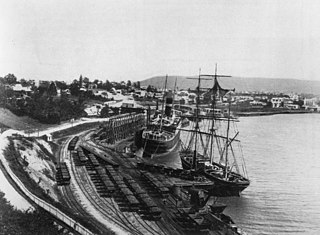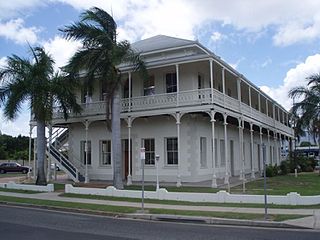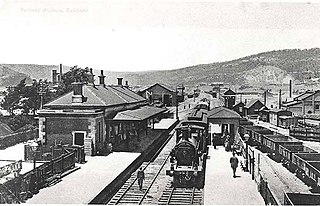
South Brisbane railway station is a heritage-listed railway station at 133 Grey Street, South Brisbane, City of Brisbane, Queensland, Australia. It is one of two stations serving the South Brisbane area, the other being South Bank. It was built from 1891 to 1918, making it the second oldest railway station in central Brisbane. It is also known as Cultural Centre Station, Melbourne Street Station, and South Brisbane (Interstate) Station. It was added to the Queensland Heritage Register on 21 October 1992.

Canterbury railway station is a heritage-listed railway station located on the Bankstown line at Canterbury in the City of Canterbury-Bankstown local government area of New South Wales, Australia. The station is served by Sydney Trains T3 Bankstown line services. The station was designed by New South Wales Government Railways and built from 1895 to 1915 by J. J. Scouller. It is also known as Canterbury Railway Station group. The property was added to the New South Wales State Heritage Register on 2 April 1999.

Woolloongabba is a suburb in the City of Brisbane, Queensland, Australia. In the 2016 census, Woolloongabba had a population of 5,631 people.

Wollongong railway station is a heritage-listed railway station on the South Coast railway line in New South Wales, Australia. It serves the central business district of Wollongong. It was added to the New South Wales State Heritage Register on 2 April 1999.

Cooroy railway station is a heritage-listed railway station at 14 Myall Street, Cooroy, Shire of Noosa, Queensland, Australia. It is on the North Coast railway line serving the town of Cooroy. It was designed by the Office of the Chief Engineer of Queensland Rail and built in 1890 by Fitzwilliam Williams. It opened on 17 July 1891 with the opening of the line from Cooran. It was added to the Queensland Heritage Register on 14 August 2008.

Mount Crosby pumping station is a heritage-listed pumping station and weir at Stumers Road, Mount Crosby, City of Brisbane, Queensland, Australia. It is located on the Brisbane River and extends into Chuwar on the other side of the river. The facility supplies water to Brisbane and nearby cities and towns within the SEQ Water Grid. It was originally designed by Charles H McLay and built from 1891 to 1892. The historic parts of the facility were added to the Queensland Heritage Register on 25 October 2019. It is also listed on the Brisbane Heritage Register, together with numerous associated facilities which were not included in the state heritage listing.

Armidale railway station is a heritage-listed railway station at 240 Brown Street, Armidale, New South Wales, Australia. It was built from 1882 to 1883 by Edmund Lonsdale and Henry Sheldon Hoddard, and was opened on 3 February 1883 when the line was extended from Uralla. It was the terminus of the line until it was extended to Glen Innes on 19 August 1884. It was added to the New South Wales State Heritage Register on 2 April 1999.

South Brisbane Dry Dock is a heritage-listed dry dock at 412 Stanley Street, South Brisbane, City of Brisbane, Queensland, Australia. It was designed by William David Nisbet and built from 1876 to 1887. It is also known as the Government Graving Dock. It was added to the Queensland Heritage Register on 21 October 1992.

The Wooloongabba Branch railway line was a branch line off the South Coast railway line in the inner southern suburbs of Brisbane, Australia. It opened on 2 June 1884 to serve the wharves and industries along the Brisbane River at Woolloongabba and South Brisbane. Queensland Railways always referred to the line as the Wooloongabba Branch, despite the official spelling of the suburb it ran through being Woolloongabba.

Toowoomba railway station is a heritage-listed railway station on the Western line at Russell Street, Toowoomba, Toowoomba Region, Queensland, Australia. It serves the city of Toowoomba, which is the junction for the Western, Main and Southern lines. The station has one platform with a passing loop, opening in 1867. It was designed by FDG Stanley and built in 1873 by R. Godsall. It was added to the Queensland Heritage Register on 21 October 1992.

The Main Line is a railway line in South East Queensland, Australia. It was opened in a series of sections between 1865 and 1867. It commences at Roma St Station in Brisbane and extends west 161 km to Toowoomba. It is the first narrow gauge main line constructed in the world. The section of the line from the end of Murphys Creek railway station to the Ruthven Street overbridge, Harlaxton is listed on the Queensland Heritage Register. The Murphys Creek Railway Complex, the Lockyer Creek Railway Bridge (Lockyer), the Lockyer Creek Railway Bridge and Swansons Rail Bridge are also heritage listed.

Woolloongaba Post Office is a heritage-listed former post office at 765 Stanley Street, Woolloongabba, City of Brisbane, Queensland, Australia. It was designed by Thomas Pye and built in 1905 by Thomas Rees. It is also known as Woolloongabba Post & Telegraph Office. It was added to the Queensland Heritage Register on 24 January 2003.

Taylor–Heaslop Building is a heritage-listed commercial building at 10–14 Logan Road, Woolloongabba, City of Brisbane, Queensland, Australia. It was designed by John Beauchamp Nicholson and built from 1889 to 1890. It is also known as Ernest Reid (draper), John Evan's Cash Draper, George Logan Draper, Johns & Co Draper, People's Cash Store (grocers), JR Blane, and Moreton Rubber Works. It was added to the Queensland Heritage Register on 6 February 2006.

Pollock's Shop House is a heritage-listed general store at 617–619 Stanley Street, Woolloongabba, City of Brisbane, Queensland, Australia. It was built c. 1865. It was added to the Queensland Heritage Register on 21 October 1992.

Maryborough railway station is a heritage-listed railway station at Lennox Street, Maryborough, Fraser Coast Region, Queensland, Australia. It is on the North Coast line serving the city of Maryborough. It was designed by Chief Engineer of the Queensland Railways Department and built from 1878 to 1890 by John Roddam & John Walker. It was added to the Queensland Heritage Register on 21 October 1992.

The Railway Administration Building is a heritage-listed former office building at 233 Denison Street, Rockhampton, Queensland, Australia. It was built in 1886. It was added to the Queensland Heritage Register on 12 July 2005.
The WH Paxton & Co. Buildings are a heritage-listed group of offices and warehousing at 10 River Street, Mackay, Mackay Region, Queensland, Australia. The 1899 sections were designed by Mackay architect Arthur Rigby and constructed by Charles Porter and Joseph Vidulich (warehouse). The 1912 warehouse extension was designed by Brisbane architect Montague Talbot Stanley. It was added to the Queensland Heritage Register on 14 August 2008.

Eagle Farm Racecourse and Ascot Railway station is a heritage-listed pair of racecourse and railway station at 230 Lancaster Road, Ascot, City of Brisbane, Queensland, Australia. It was built from 1863 onwards. The racecourse is also known as Ascot Racecourse and Brisbane Racecourse, and Ascot railway station was previously known as Racecourse railway station. It was added to the Queensland Heritage Register on 25 June 2004.

The 1873 Roma Street railway station building is a heritage-listed railway station building at Roma Street railway station, 159 Roma Street, Brisbane central business district, City of Brisbane, Queensland, Australia. It was designed by Francis Drummond Greville Stanley and built from 1873 to 1875 by John Petrie. It is also known as Brisbane Passenger Station, Brisbane Terminal Station, and Brisbane Terminus. It was added to the Queensland Heritage Register on 24 March 2000.

The Eskbank railway station is a heritage-listed former locomotive depot and railway station and now community group venue adjacent to the Main Western Line at Lithgow, City of Lithgow, New South Wales, Australia. It was designed by the New South Wales Government Railways and the station building was built by Goodsell & Wright, as a contractor. It is also known as Eskbank Railway Station group and Lithgow Goods Station/ Lithgow Site S1. The property was added to the New South Wales State Heritage Register on 2 April 1999.




















